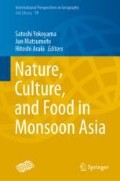Abstract
Nepal is located on the southern face of the Himalayas; as a result, geographical and cultural diversities have nurtured its unique gastronomic culture. It is difficult for people living in remote areas to obtain fresh vegetables and meat because of a lack of transportation and electricity, and these restrictions have sparked several local gastronomic cultures. For example, to preserve vegetables and meat, people living in rural areas tend to dry and smoke them. In Nepalese Hindu society, there are taboos on the consumption of certain food and drink, such as meat and alcohol. Recent data suggest that Nepalese people began to eat meat because of economic development and globalization. These sociocultural changes and the development of transportation networks have together promoted homogenization of food throughout Nepal. However, people also seek locality and “authenticity” in their food. For example, dāl-bhāt, an “authentic” Nepalese food, has been particularly prevalent in Nepal since the development of transportation services. Furthermore, as Nepalese people have begun traveling abroad, dāl-bhāt has spread even beyond Nepalese national borders.
Access this chapter
Tax calculation will be finalised at checkout
Purchases are for personal use only
Notes
- 1.
Nepal was the Hindu monarchical state that had built a hierarchical society based on caste, ethnicity, race, and gender. The nation’s remoteness had also brought about other diversities in Nepalese society. Since 2006 there have been increasing demands for restructuring the modalities of establishing a multi-cultural, multi-social, multi-linguistic, multi-religious, and multi-ethnic federal state. This chapter will examine the transformation of food and its sociocultural climate in this context.
- 2.
Indeed, some Buddhists of Nepal also have religious taboos against eating meat.
- 3.
- 4.
This is an example from a local restaurant in a tourist area in Kathmandu. Guests who came here to eat dāl-bhāt were usually Nepalese people; therefore, this set of dishes can be understood as a local type of dāl-bhāt for native Nepalese, not a “Nepalese ethnic cuisine” for international tourists.
- 5.
Formally, there are no more untouchable castes; however, discrimination based on the Hindu caste system still exists in Nepal.
- 6.
In 1996, the Maoists had launched a “People’s War,” which lasted for ten years, to overthrow the political establishment, including the monarchy of the Kingdom of Nepal.
- 7.
Other than the Nepalese, Nepal has imported frozen beef from Calcutta since the 1970s for foreign tourists to consume.
- 8.
One US dollar was worth approximately 96 Nepalese rupees in 2014.
- 9.
- 10.
Excluding fish, meat products include buffalo, goat, sheep, pork, and poultry. The world’s average annual meat consumption is approximately 42.5 kg per person, while in developing countries it is approximately 32.4 kg per person. Nepal is still far behind other developing countries (e-Kantipur 2015).
- 11.
The Thakali, whose dāl-bhāt has a reputation for being delicious, are an ethnic group from Northwest Nepal.
- 12.
According to Kharel (2017), Tokyo has the largest concentration of Nepali-owned restaurants, with over 500 distributed throughout the metropolitan area.
- 13.
The Newar are an ethnic group from Kathmandu.
References
e-Kantipur (2014) Per capita meat consumption up to 11 kg. http://kathmandupost.ekantipur.com/news/2014-05-16/per-capita-meat-consumption-up-11-kg.html. Accessed 20 Sept 2017
e-Kantipur (2015) Meat production projected to inch up to 301 k tonnes. http://kathmandupost.ekantipur.com/printedition/news/2015-06-10/meat-production-projected-to-inch-up-to-301k-tonnes.html. Accessed 20 Sept 2017
Kharel D (2017) A multi-sited visual ethnographic study on the Nepali migration from Malma to Japan: network migration, transnational ties, and social transformation. PhD Dissertation, University of Tokyo
Liechty M (2010) Out here in Kathmandu: modernity on the global periphery. Martin Chautari, Kathmandu
Morimoto I (2015) Tourism, consumption and the transformation of Thamel, Kathmandu. In: Bates C, Mio M (eds) Cities in South Asia. Routledge Taylor and Francis Group, London
Pathak J (2008) Taste of Nepal. Adarsh Books, New Delhi
Thapa R (2016) Thamel: dark star of Kathmandu. Speaking Tiger, New Delhi
The Himalayan Times (2015 Oct 10) Prices of daily commodities up. The Himalayan Times. https://thehimalayantimes.com/nepal/prices-of-daily-commodities-up/. Accessed 20 Sept 2017
World Food Programme Nepal (2007) Market watch 2: food grain market. Rome: United Nations World Food Programme. https://reliefweb.int/sites/reliefweb.int/files/resources/Market%20Watch%2002_English.pdf. Accessed 20 Sept 2017
World Food Programme Nepal (2009) Market watch 20. Rome: United Nations World Food Programme. https://reliefweb.int/sites/reliefweb.int/files/resources/ 1E4A5401E0791182492576B6001FB1FF-Full_Report.pdf. Accessed 20 Sept 2017
World Food Programme Nepal (2010) The life of food in Nepal. The United Nations World Food Programme, Kathmandu
World Food Programme Nepal (2011a) Market watch 28. Rome: United Nations World Food Programme. http://neksap.org.np/uploaded/market_watch/Market%20Watch%2028_English.pdf. Accessed 20 Sept 2017
World Food Programme Nepal (2011b) Market watch 36. Rome: United Nations World Food Programme. http://home.wfp.org/stellent/groups/public/documents/ena/wfp239091.pdf. Accessed 20 Sept 2017
World Food Programme Nepal (2012) Market watch 48. Rome: United Nations World Food Programme. http://neksap.org.np/uploaded/market_watch/Market%20Watch-48-English.pdf. Accessed 20 Sept 2017
World Food Programme Nepal (2013) Market watch 60. Rome: United Nations World Food Programme. http://neksap.org.np/uploaded/market_watch/Market%20Watch-60_English.pdf. Accessed 20 Sept 2017
World Food Programme Nepal (2014) Market watch 72. Rome: United Nations World Food Programme.http://documents.wfp.org/stellent/groups/public/documents/ena/wfp271783.pdf?_ga=2.48436325.2139949954.1507282526-1363768854.1506069186. Accessed 20 Sept 2017
World Food Programme Nepal (2015) Market watch 85. Rome: United Nations World Food Programme. https://reliefweb.int/sites/reliefweb.int/files/resources/Market%20Watch-85_English.pdf. Accessed 20 Sept 2017
World Food Programme Nepal (2016) Market watch. Rome: United Nations World Food Programme. http://documents.wfp.org/stellent/groups/public/documents/ena/wfp281178.pdf?ga=2.82784400.763477756.1505971428-446572650.1505971428. Accessed 20 Sept 2017
Acknowledgements
This research was partially supported by the JSPS KAKENHI, Grant Number 19720220 from 2007 to 2009.
Author information
Authors and Affiliations
Corresponding author
Editor information
Editors and Affiliations
Rights and permissions
Copyright information
© 2020 Springer Nature Singapore Pte Ltd.
About this chapter
Cite this chapter
Morimoto, I. (2020). Nepalese Food and Its Sociocultural Climate: Changing Dāl-bhāt Inside and Beyond Nepal. In: Yokoyama, S., Matsumoto, J., Araki, H. (eds) Nature, Culture, and Food in Monsoon Asia. International Perspectives in Geography, vol 10. Springer, Singapore. https://doi.org/10.1007/978-981-15-2113-3_8
Download citation
DOI: https://doi.org/10.1007/978-981-15-2113-3_8
Published:
Publisher Name: Springer, Singapore
Print ISBN: 978-981-15-2112-6
Online ISBN: 978-981-15-2113-3
eBook Packages: Earth and Environmental ScienceEarth and Environmental Science (R0)

